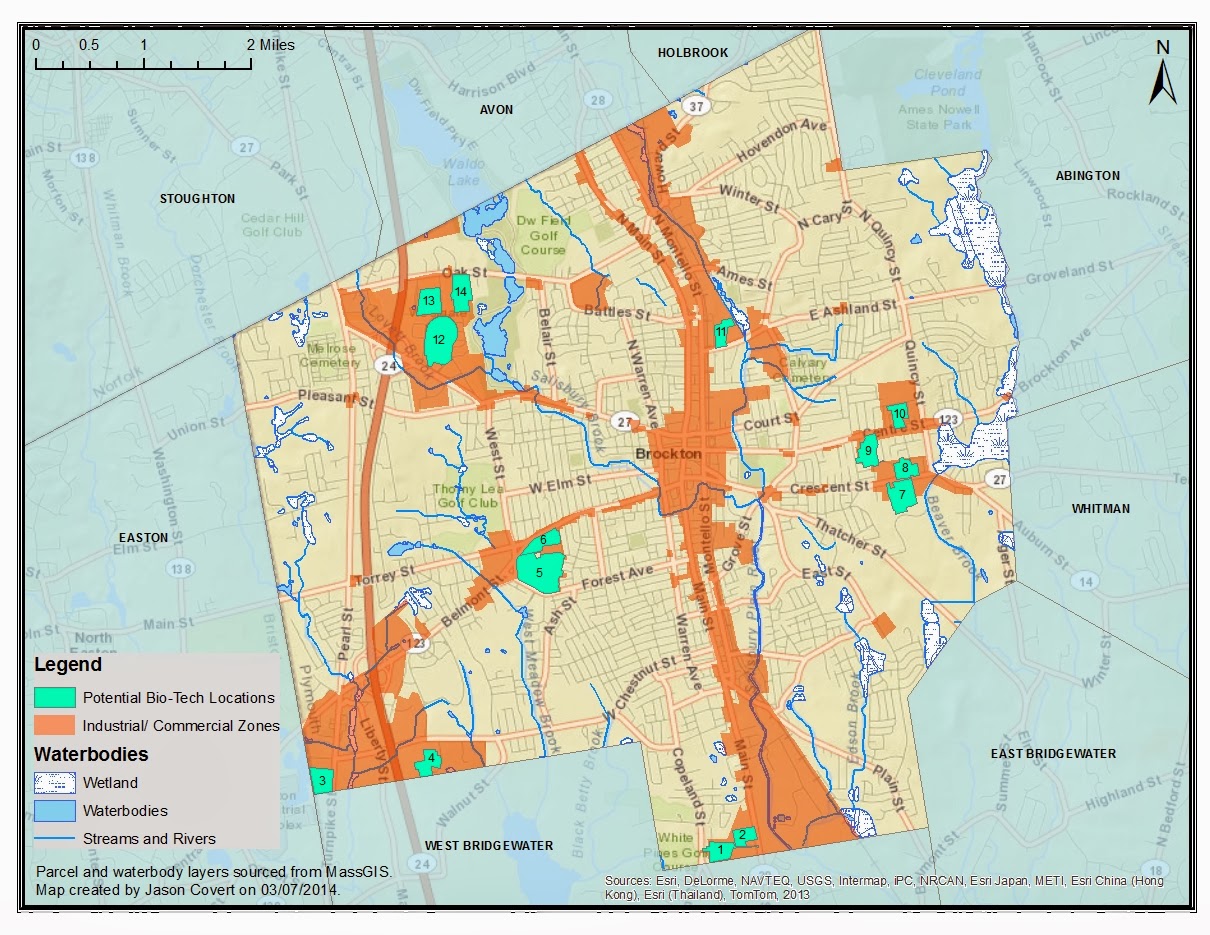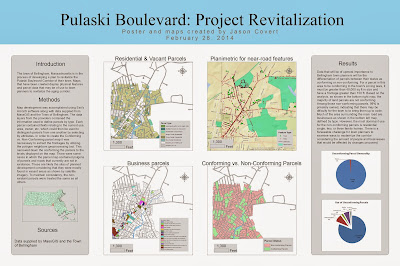The poster below compares fire truck response times in my hometown, Pembroke Massachusetts, under two scenarios. Scenario 1 assumes that all four of the town's fire stations are active. Scenario 2 assumes that the North Pembroke Station is closed due to town budget reasons and shows the difference in response times when compared to scenario 1. This has been an actual debate in the Town of Pembroke as the North Pembroke station is currently not staffed. Due to the industrialized nature of North Pembroke there has been concern that fire truck response time would be too long for the area in the event of a major fire at one of the commercial facilities. From the comparison, we can see that having the North Pembroke station open does improve the response time for the industrial areas down to the national standard of 5 minutes. There is, however, much overlapping in the southern portion of its service areas making it redundant in that area. All things considered for maximum safety, it would be an important asset to the town.
My GIS Chronicle
Monday, May 5, 2014
Friday, May 2, 2014
Distance Analysis for Massachusetts Community Colleges
The poster below compares two methods of visualizing distance using ArcMap, Network Analysis, and the Euclidean Distance Tool. Network Analysis uses established road networks to determine a driving distance from a set location, which was Massachusetts Community Colleges in this case. Euclidean Distance, could be considered "as the crow flies," and does not take road networks into account. As far as visual appeal and usefulness goes, it appears that Network Analysis provides the superior output. Because it takes road travel into account, it would be more useful to determine distances students or faculty would need to travel to get to individual community colleges in Massachusetts.
Thursday, May 1, 2014
My GPS Map
Below is a map demonstrating the use of a GPS to geospatially track a route. This map shows route 14 which was the subject of field testing for my undergraduate research project. My goal was to track the change in air temperatures and relate it to the location's distance from the coast. However, because of the lack of a way to correspond temperature readings taken along with location, I used this method to approximate distances along the route. Each point, for runs 5 and 6 was taken at 1 minute intervals along the route travelling east and the pins represent the approximate distance between the two runs. This gave me an average location on the route allowing me to relate temperatures taken at a given location.
View Larger Map
View Larger Map
Wednesday, April 16, 2014
Geocoding Community Colleges
Like geographic coordinates, geocoding is a method to plot points on a map. However, instead of using latitude and longitude, geocoding uses street addresses, states/provinces, and zip codes to find locations. It is not as versatile as using geographic coordinates because every country has a different geocoding method, but it is widely used, especially in online applications like Google Maps.
For this brief assignment, I collected addresses of Massachusetts community colleges and geocoded their locations on a map. For the purposes of analysis, I also included population densities of Massachusetts towns and major highways. Based on the analysis it appears as though every community college is located in a town with a population density greater than that of surrounding towns. They are also located close to major highways making them very accessable. Considering that they all sit within towns that have high population densities, it appears that Massachusetts Community Colleges has done a good job planning locations that best serve the most people.
Wednesday, March 26, 2014
A Search for Potential Locations of a Solar-Wind Farm
For this exercise we created a scenario where two Plymouth County towns were collaborating to identify suitable areas for a combined solar and wind farm using raster data. Displayed on the poster below are locations in Kingston and Pembroke which meet the set criteria of having topography with less than a 15 degree slope and are at a southerly aspect between 135 and 225 degrees. The areas which meet the topography criteria must also be in a zone with an average wind speed greater than 5 m/s at 30 m. This analysis was accomplished using Esri's GIS software and datalayers provided by Massachusetts GIS. Locations were identified through utilizing tools such as slope and aspect in ArcGIS to manipulate a digital elevation model of Massachusetts. Using the DEM, it was possible to map the terrain's slope in degrees and the direction that each slope faces. When calculated with a 30 m wind speed grid from Mass GIS, the results are displayed as locations which meet all three of the minimum criteria.
To view an interactive version of the map above please click the link HERE.
The Google Earth platform is versatile and easy to share. Combined with recent imagery, it can be used for certain analysis relating to this project. The KML files below display the sites in Kingston and Pembroke which meet the minimum criteria.
Pembroke, Massachusetts
Friday, March 7, 2014
City of Brockton: Potential Locations for a New Bio-Tech Industrial Park
INTRODUCTION
The following is a map
(figure 1) representing potential locations for the establishment of a bio-tech
industrial park in the City of Brockton. The potential locations were
determined using data from Massachusetts GIS and the following criteria
provided by the city:
1.
The parcel has
to be at least 10 acres in area.2. The parcel has to be 50 feet from any wetland or waterbody.
3. The parcel has to be already industrial or commercial zoned.

| Figure 1: Potential locations for bio-tech industrial park in Brockton, MA
POTENTIAL PARCEL DATA
RESULTS
After
the set criteria were applied to parcel data for the City of Brockton, fourteen
parcels were found to be potential locations for the establishment of a
bio-tech industry. All are contained within an industrial or commercial zone,
are fifty feet or more from hydrological features, and are over ten acres in
area. While the fourteen highlighted parcels on the map are potential, some are
less suitable than others. For the purposes of identifying each parcel on the
map, they have been assigned a unique number identifier. Potential parcels, 1,
3, 4, 7, 10, 11, 12, and 14 would not be ideal because they are currently
occupied by businesses which have minimal space for construction of new
buildings. Parcel 9 appears to have the most potential as it is a decent sized
parcel, with room for construction, and nearby to Brockton Hospital which will
likely be interested in partnering with new bio-tech firms. Considering the
location relative to the hospital, the area could become considered the
healthcare district of the city which would help it be recognized by new
bio-tech companies. The remaining parcels have similar characteristics, but are
farther from the hospital and have slightly less building area. They would,
however, all serve as good alternatives if problems arose in parcel 9.
ANALYSIS
It
is recommended that further analysis be done to determine what potential
parcels are being used for specifically, who are the owners who may be affected
by any changes, and what is the total value is of the parcel. For the purposes
of this report, the use type shown in Table 1, was determined by looking at
satellite imagery of the parcels. This would help in developing a plan of
action to transform the parcel to a state that would be desirable for bio-tech
companies. Finding the value of the parcel will be required so the city can
determine how much it will cost to buy up the properties if that is deemed
necessary for construction. There are also environmental criteria that should
be considered. Geological analysis may need to be done to determine how
susceptible the area is to groundwater contamination by the new industries.
There are data layers provided by MassGIS that may be of use for this analysis.
Proximity to residential areas may also be an area of concern, and if this is
considered, Parcel 9 may not be an ideal location as it is primarily surrounded
by single family homes.
Given
the size of land necessary for the development of a bio-tech industrial park,
there are alternative options to constructing new buildings on existing
commercial parcels. Buying and renovating buildings already in existence may be
a more cost effective plan for the city to pursue. There is also the option of
reducing the minimum ten acres criteria by constructing a multi-story building.
This would be more space efficient and can accommodate the same amount, if not
more, businesses. By reducing the acreage criteria, there would be more options
for placement of the area.
PROCESS
The
primary tool used to complete this report was ESRI’s ArcGIS software. The
methods that were used are highlighted below in simple steps that will allow it
to be replicated by any town wishing to do the same analysis (Figure 2). The
primary tool within ArcGIS that was used was “select by attributes” and “select
by location.” It will be necessary to select from current selection between
each process step highlighted below. The final layer was produced from the
final selection, which minimized the original parcel amount to the fourteen
which met the criteria established. It may be possible to streamline this
process by creating a script and changing the parameters according to the town
being analyzed in that script. All the data is available for no cost on the
MassGIS website.
Figure 2
|
Sunday, March 2, 2014
Pulaski Boulevard: Project Revitalization

Pulaski Boulevard is the subject of the latest revitalization project proposed by the Town of Bellingham, Massachusetts. Pulaski Boulevard is a main street, lined with small businesses, that intersects a corridor that is riddled with aging buildings and nonconforming land parcels. It will be necessary for town planners to identify which parcels do not comply with the zoning laws and to determine who will be effected by any changes. For this task, we have GIS.
Above is a presentation in poster format designed to assist town planners in moving forward with the revitalization of Pulaski Boulevard. In the maps on the left, residential parcels and businesses were identified by type. The map in to top right shows near-road features that may be of importance to town planners like street trees, telephone poles, and sidewalks. In the bottom right, parcels were distinguished based on their status as conforming or nonconforming to Bellingham's current zoning laws. The criteria used to identify the conforming parcels was a size of over 40,000 sq ft and a frontage of over 150 ft. As is clearly shown, the majority of land parcels are nonconforming.
Subscribe to:
Comments (Atom)





